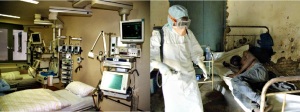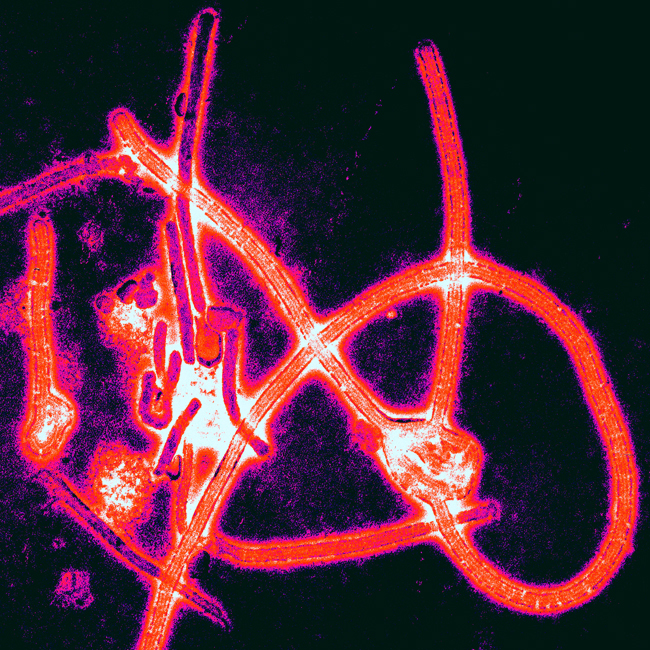If you are in America, breathe easy. Ebola is NOT a big threat to your health.
Ebola is a public health nightmare in affected African countries. The outbreak is still spreading, and may infect over one million people by next year. This is devastating for both the health of citizens and the stability of governments in affected countries.
However, that’s not the whole story. First, let’s move our thinking about this outbreak away from our cozy, American, well-equipped healthcare system context (although it is not without problems) and place it in the context of affected African nations.

On the left, a hospital in a wealthy nation (Germany). On the right, a health care worker providing care to an Ebola patient. Notice the difference?
Even before Ebola struck, building capacity to provide good healthcare in Africa has been a huge challenge, drawing interest from sweeping plans like the Millennium Development Goals and government aid, as well as from smaller scale donors like foundations, charities, and individuals. The combination of aid and donations represent a substantial portion of the money spent on healthcare in Africa. Unfortunately, many of the interventions and treatment centers that are funded by global public health institutions and foundations focus on handling one disease or problem at a time (like the Direct Observed Treatment Short-Course, or DOTS, program for TB treatment), rather than either holistic approaches to health or underlying issues (poverty, unemployment, lack of health care). While these interventions do some good, this is also unfortunate for a few reasons:
- The diseases chosen may not align with the needs of the community.
- Money may be earmarked so it can ONLY be spent on a specific disease (HIV/AIDS money is the classic example of this).
- Approaching health problems individually doesn’t make good medical sense: if you had the flu, an ulcer, and an infected finger, you wouldn’t want the doctor to treat your finger and ignore the rest.
While these programs have definitely helped (check out here and here for some nice examples), non-Ebola problems remain rampant, and they feed off of each other synergistically.
HIV/AIDS causes ~1.6 million deaths per year, with 69% of people with HIV/AIDS living in sub-Saharan Africa. Malaria causes ~627,000 deaths per year, with over 90% of them in Africa and many of them in children under the age of 5. Tuberculosis is a common co-infection with HIV, and causes hundreds of thousands of new cases per year in Africa. Children with HIV, TB, or malaria are more vulnerable to diarrheal disease, which, because of lack of access to clean water, kills hundreds of thousands of children each year. The amount of money to fight these (and many other diseases) is a tiny fraction of the money we spend on health care in America. Furthermore, malnutrition exacerbates ALL of these problems; people (especially children) who are malnourished are far more vulnerable to infectious disease.

Map showing the number of stunted children around the globe. Note the heavy concentration of stunting in Africa and Southeast Asia. Source: UNICEF
Treating these problems individually doesn’t offer the cheapest or most comprehensive care. Multiple studies have suggested that coordinating donor aid and providing holistic treatment could lead to better health and economic outcomes. For example, people with HIV are very likely to become infected with TB because their immune system is weakened. Case detection for both diseases, medication access, and other unrelated health programs (like vaccination) improve when HIV and TB are treated simultaneously. Training microscopists identify both malaria and TB is simple, and would allow for more targeted and higher quality treatment (avoiding drug interactions and other potential dangers). Treating diseases in the same location would allow patients to receive more comprehensive care while saving them time and money in transportation, lost work hours, and other opportunity costs. With more money to spend, families could buy more food and better medicine.
So, you say, why are these diseases with known treatments such problems? Why don’t African countries just solve these problems themselves?
It’s not that these are “backwards people” who are “stuck in their primitive ways”. To some extent, it’s because of choices made by governments (African and Western), businesses, and global public health institutions. These choices influence who lives and who dies. Below are some relevant decisions:
- International aid is a challenging beast. There is a long history of aid embezzlement by corrupt leaders in kleptocracies. Because of this, simply throwing money at a problem doesn’t necessarily work, and can even make things worse. On the other side of the coin, Western nations have used aid as a tool to prop up dictatorships and implement unpopular economic policies that benefit international businesses rather than the people who are supposedly being helped.
- Colonialism, the ‘scramble for Africa‘, and post-colonial toppling of democratically elected leaders by Western-backed coups make it challenging African governments and citizens to trust foreign institutions. For an engaging and devastating study of colonialism in the Congo, check out ‘King Leopold’s Ghost’ by Adam Hothschild (excerpts here, buy it here).
- While the African continent is full of natural riches (including many that we depend upon for our currently lifestyle), many countries suffer from the ‘resource curse’; their natural wealth has not translated into good living conditions.
- The exploitation of these resources by both African government sand international businesses has led to massive inequality, breeding corruption in governments that enriches leaders while failing to provide infrastructure and public safety nets for the people. This has hit some countries harder than others, reflecting the importance of good leadership and governance. For instance, Botswana and Ghana have far fewer issues with corruption than Nigeria or the Democratic Republic of the Congo.
- The piecemeal global public health approach has helped alleviate some issues with healthcare, but cannot address these underlying issues. Nor is it well coordinated enough to fully deal with healthcare issues before Ebola struck.
Ebola has reared its head in this already dysfunctional mix. The destruction of rich ecosystems (along with the livelihoods of people in them) by resource exploitation has led to the rise of slums and conditions that may allow Ebola to become more prevalent. The burden of the diseases listed above contribute to the rapid spread and deadliness of Ebola. People with other health problems have weakened immune systems, and are thus more likely to be infected and less likely to recover. The existing healthcare systems aren’t adequate to tackle the existing problems, and a new and deadly disease like Ebola puts immense strain on an already weak system. The tumultuous past of colonialism has even helped generate fears that Ebola is a Western conspiracy, making people afraid to seek treatment. The Ebola epidemic is exacerbating Africa’s public health crisis, and vice versa.
Thus, the Ebola outbreak reveals something far worse than the terrifying nature of Ebola itself. We are in a REACTIVE rather than a PROACTIVE place for Ebola AND for many of the diseases listed above.

Yikes!
However, this is an important point in history: there is a huge amount of international momentum that is determined to shut down the Ebola outbreak.
We in wealthy nations must think about ways to take advantage of and continue building this momentum. Let’s partner with African communities and governments fighting Ebola to develop and implement ways of handling multiple public health problems (including Ebola) in culturally responsive and meaningful ways. Let’s think about ways to coordinate donor aid to make the best use of resources to build public health infrastructure that provides training for healthcare workers and targets public health holistically. This is also a time for honest reflection about the underlying reasons why the outbreak occurred in the first place, and what can be done to prevent it in the future. This could come in several forms:
- Being more judicious with government aid. This could be done by tying aid to reforms that build healthcare capacity and provide a social safety net for the general citizenry, rather than handing over checks without any strings attached.
- Putting pressure on businesses that collude with corrupt governments through boycotts and international business regulations.
- Moderating ecosystem destruction through international and local regulations that better ensure responsible resource extraction. This would protect the livelihoods of people in resource-rich regions and have the added benefit of protecting the environmental buffer that helps prevent the rapid spread of disease.
If we don’t start moving to address these larger issues, I fear that after this outbreak we’ll go back to doing little about the systemic public health problems plaguing African countries, leaving us waiting for a new outbreak rather than actively trying to prevent one.
References
Shiffman, Jeremy. “Donor funding priorities for communicable disease control in the developing world.” Health Policy and Planning 21.6 (2006): 411-420. DOI
Vasan, Ashwin, et al. “Integrated care as a means to improve primary care delivery for adults and adolescents in the developing world: a critical analysis of Integrated Management of Adolescent and Adult Illness (IMAI).” BMC medicine12.1 (2014): 6. DOI
Lienhardt, C. and J.A. Ogden, Tuberculosis control in resource-poor countries: have we reached the limits of the universal paradigm? Tropical Medicine & International Health, 2004. 9(7): p. 833-841. DOI
John Maurice. “WHO meeting chooses untried interventions to defeat Ebola”. The Lancet – 20 September 2014 ( Vol. 384, Issue 9948, Pages e45-e46 ) DOI
Lugada, Eric, et al. “Rapid implementation of an integrated large-scale HIV counseling and testing, malaria, and diarrhea prevention campaign in rural Kenya.” PloS one 5.8 (2010): e12435. DOI
Kahn, James G., et al. “Integrated HIV testing, malaria, and diarrhea prevention campaign in Kenya: modeled health impact and cost-effectiveness.” PloS one7.2 (2012): e31316. DOI

